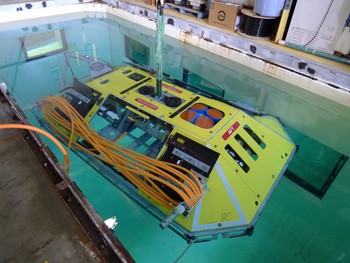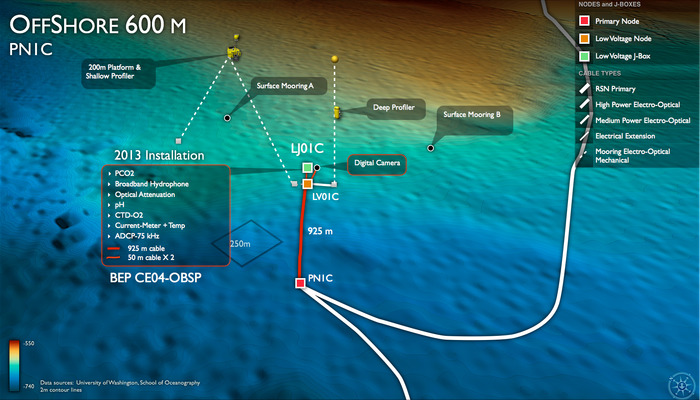
The Benthic Experiment Package (BEP) is composed of a hazard-resistant frame (shown here), the inside of which hosts an UW-APL-designed Low Power communications housing, and a variety of sensors to measure oceanographic properties that include acidity (pH), carbon dioxide, salinity and oxygen concentrations, and currents. A hydrophone that will be mounted outside of the frame will be used to detect sounds in the ocean.
The BEP is scheduled for installation in 2014 at the Endurance Offshore site that is part of the Endurance Array's Newport Line. This site is also the location of one of the RSN Primary Nodes, which is the power and data hub for the BEP Low-Power Junction Box, which is in turn the power and data hub for a variety of instrument platforms.
Location: 44.2ºN 124.6ºW Water Depth: 585 to 615 meters
The Endurance Offshore Study Site at Primary Node PN1C will host two cabled moorings and and one uncabled mooring, as well as a seafloor Benthic Experiment Package (BEP). Shared with RSN, this Endurance Array site, led by Oregon State University, is part of two cross-margin instrumented arrays along the Oregon (west of Newport) and Washington margins (west of Grays Harbor). The Newport Endurance Line consists of both cabled and uncabled moorings and seafloor infrastructure, while the Grays Harbor site consists of uncabled moorings. These sites are designed to examine biogeochemical and physcial oceanographic processes within these highly productive coastal environments. The ecosystems are significantly impacted by wind-driven upwelling of nutrient-rich currents, and at times by hypoxia events. In addition to the moorings and seafloor instruments, a series of autonomous gliders will travel from the near shore to deep waters and will provide three-dimensional measurements of ocean chemistry, biology, and currents.
In 2014 a Benthic Experiment Package will be sited at 585 meters water depth and will house the following instruments:
- Broadband Hydrophone
- Acoustic Doppler Current Profiler (ADCP)
- Conductivity-Temperature-Depth (CTD) and Dissolved Oxygen Sensors
- Turbulent-Flow Current Meter (VEL3D)
- pH and CO2 Sensors
- Optical Attenuation Sensor


